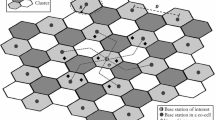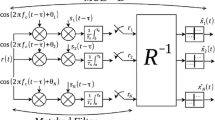Abstract
Capacity enhancement of cellular CDMA is analyzed using an asymmetrical-bandwidth-allocation approach. Cellular CDMA systems with and without successive interference cancellation are considered. The main source of interference is interuser interference and, in particular, a 9-cell configuration is employed to account for interference from surrounding cells. By transferring more bandwidth or, equivalently, processing gain from the forward link to the reverse link, we have effectively balanced their performance and raised the overall capacity of the cellular system. The optimum bandwidth allocation is easily obtained from the performance curves of both links. For a typical cellular CDMA with a bit error rate of 10-3, the capacity gain of this approach is about 40%. If successive interference cancellation is employed and both links have the same quality, then both links should have equal bandwidth. However, in a situation where imperfect power control occurs, our studies indicate that using interference cancellation alone achieves a 25% increase in capacity, while enhancement with an asymmetrical bandwidth allocation overlay raises this gain to 68%.
Similar content being viewed by others
References
K.S. Gilhousen et al., “On the capacity of a cellular CDMA system,” IEEE Trans. Veh. Technol., Vol. 40, No.2, pp. 303–312, May 1991.
M.B. Pursley, “Performance evaluation for phase-coded spread spectrum multiple-access communications, part I: system analysis,” IEEE Trans. Commun., Vol. COM-25, pp. 795–799, Aug. 1977.
L.B. Milstein, T.S. Rappaport, R. Barghouti, “Performance evaluation of cellular CDMA,” IEEE J. Select. Areas Commun., Vol. 10, No.4, pp. 680–689, May 1992.
O.K. Tonguz, M.M. Wang, “Cellular CDMA networks impaired by Rayleigh fading: system performance with power control,” IEEE Trans Veh. Technol., Vol. 43, No.3, pp. 515–527, Aug. 1994.
G.L. Stüber, C. Kchao, “Analysis of a multiple-cell direct sequence CDMA cellular mobile radio system,” IEEE J. Select. Areas Commun., Vol. 10, No.4, pp. 669–679, May 1992.
FCC Report, Vol. 13, No.5, March 10, 1994, pp. 10.
J.M. Holtzman, “DS/CDMAsuccessive interference cancellation,” Proc. ISSTA’ 94, Oulu, Finland, pp. 69–78, July 1994.
K.H. Li, L.B. Milstein, “On the optimum processing gain of a block-coded direct-sequence spread-spectrum system,” IEEE J. Select. Areas Commun., Vol. 7, No.4, pp. 618–626, May 1989.
J.Y.N. Hui, “Throughput analysis for code division multiple accessing of the spread spectrum channel” IEEE J. Select. Areas Commun., Vol. 2, No.4, pp. 482–486, July 1984.
K.H. Li, K.L. Cheah, “Performance evaluation of cellular CDMA systems over fading channels,” Proc. APCC’ 95, Jakarta, Indonesia, pp. 8.2.1–8.2.5, Nov. 1995.
A.J. Viterbi, “Soft handoff extends CDMA cell converage and increases reverse link capacity,” IEEE J. Select. Areas Commun., Vol. 12, No.8, pp. 1281–1288, Oct. 1994.
S. Verdu, “Minimum probability of error for asynchronous Gaussian multiple access channels,” IEEE Trans. Info. Theory, Vol. IT-32, No.1, pp. 85–96, Jan. 1986.
H.V. MacDonald, “The cellular concept,” Bell System Technical Journal, Vol. 58, No.1, pp. 15–41, Jan. 1979.
J.P. Odenwalder, Error control coding handbook, Linkabit Corp., San Diego, CA, pp. 64, July 15, 1976.
M.K. Simon, Spread Spectrum Communications Handbook. New York: McGraw-Hill, 1994.
M.H. Kalos, P.A. Whitlock, Monte Carlo Methods Volume I: Basics. New York: Wiley, 1986.
K.L. Cheah, K.H. Li, “On the interference of surrounding cells in a DS-CDMA system,” Proc. IEEE SICON/ICIE’ 95, Singapore, pp. 152–156, July 1995.
A.J. Viterbi, Principles of Spread Spectrum Communication. New York: Addison Wesley, 1995.
P.R. Patel, J.M. Holtzman, “Analysis of a simple successive interference cancellation scheme in a DS/CDMA system,” IEEE J. Select. Areas Commun., Vol. 12, No.5, pp. 795–807, June 1994.
P.R. Patel, J.M. Holtzman, “Analysis of a DS/CDMA successive interference cancellation scheme using correlations,” Proc. GLOBECOM’ 93, pp. 76–80, Nov. 1993.
M. Wallace, R. Walton, “CDMA radio network planning,” Proc. ICUPC’ 94, pp. 62–67, Oct. 1994.
V.K. Bhargava, “High rate transmission of integrated traffic over wireless communication networks,” Proc. APCC’ 95, Jakarta, Indonesia, pp. 4.1.1–4.1.5, Nov. 1995.
Author information
Authors and Affiliations
Rights and permissions
About this article
Cite this article
Cheah, K.L., Li, K.H. On the Capacity Enhancement of a Cellular CDMA Channel with Asymmetrical Bandwidth Allocation. Wireless Personal Communications 6, 197–209 (1998). https://doi.org/10.1023/A:1008836418919
Issue Date:
DOI: https://doi.org/10.1023/A:1008836418919




